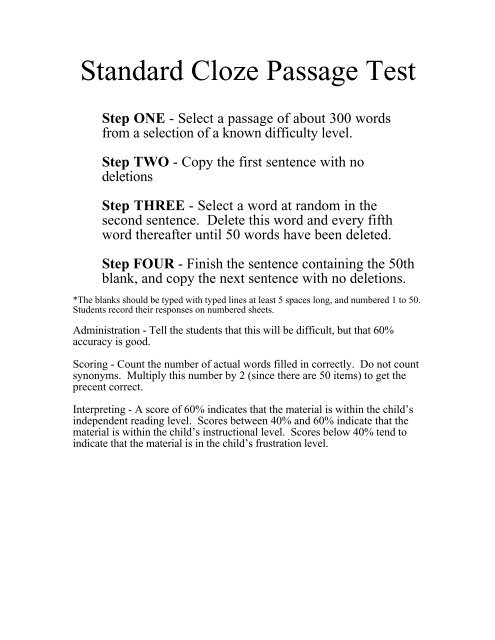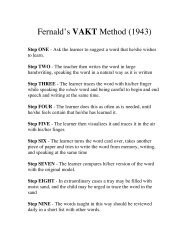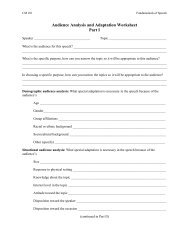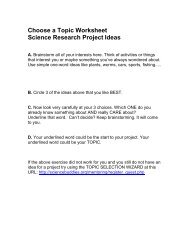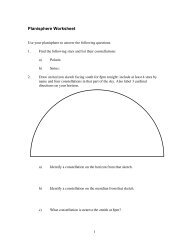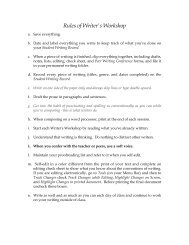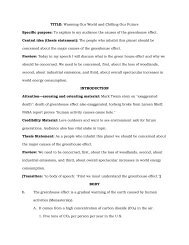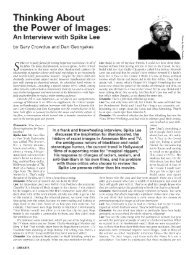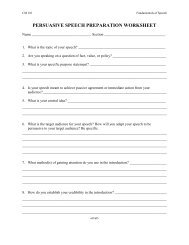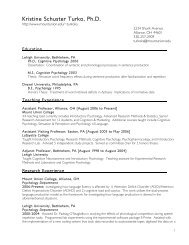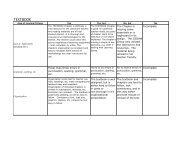Cloze Procedure - University of Mount Union
Cloze Procedure - University of Mount Union
Cloze Procedure - University of Mount Union
You also want an ePaper? Increase the reach of your titles
YUMPU automatically turns print PDFs into web optimized ePapers that Google loves.
Standard <strong>Cloze</strong> Passage Test<br />
Step ONE - Select a passage <strong>of</strong> about 300 words<br />
from a selection <strong>of</strong> a known difficulty level.<br />
Step TWO - Copy the first sentence with no<br />
deletions<br />
Step THREE - Select a word at random in the<br />
second sentence. Delete this word and every fifth<br />
word thereafter until 50 words have been deleted.<br />
Step FOUR - Finish the sentence containing the 50th<br />
blank, and copy the next sentence with no deletions.<br />
*The blanks should be typed with typed lines at least 5 spaces long, and numbered 1 to 50.<br />
Students record their responses on numbered sheets.<br />
Administration - Tell the students that this will be difficult, but that 60%<br />
accuracy is good.<br />
Scoring - Count the number <strong>of</strong> actual words filled in correctly. Do not count<br />
synonyms. Multiply this number by 2 (since there are 50 items) to get the<br />
precent correct.<br />
Interpreting - A score <strong>of</strong> 60% indicates that the material is within the child’s<br />
independent reading level. Scores between 40% and 60% indicate that the<br />
material is within the child’s instructional level. Scores below 40% tend to<br />
indicate that the material is in the child’s frustration level.
<strong>Cloze</strong> <strong>Procedure</strong><br />
Inferential <strong>Cloze</strong> Training Technique<br />
Step ONE - Begin with a cloze passage with 5 to 25 words deleted - every<br />
fifth to nine word, depending on the level <strong>of</strong> difficulty you wish for the pupil<br />
to encounter<br />
Step TWO - Pre-teach students essential vocabulary from the passage<br />
Step THREE - Beginning first with one sentence and increasing<br />
progressively to paragraphs, demonstrate to students, by sample talkthroughs,<br />
how to infer a correct word replacement by using semantic clues,<br />
syntactic clues, and background knowledge.<br />
Step FOUR - During the talk through, try to use these self-monitoring<br />
guidelines:<br />
a. Does the replacement make sense<br />
b. Does the replacement cause the sentence to make sense<br />
c. Does the replacement combine prior knowledge with clues in the<br />
passage<br />
d. Is there a forward clue in the same sentence paragraph, or<br />
passage<br />
e. Is there a backward clue in the same sentence, paragraph, or<br />
passage<br />
f. Did the clue cause you to change your replacement<br />
Step FIVE - The teacher expresses him or herself by explaining why a<br />
certain replacement seems correct, and then helps the student do the same<br />
thing by asking the student questions that aid in inferring why certain<br />
replacements are more correct than others.<br />
Step SIX - The teacher asks the students to read a second intact sentence,<br />
paragraph, or passage.<br />
Step SEVEN - The teacher checks overall comprehension with typical main<br />
idea, detail, and inferential questions.


